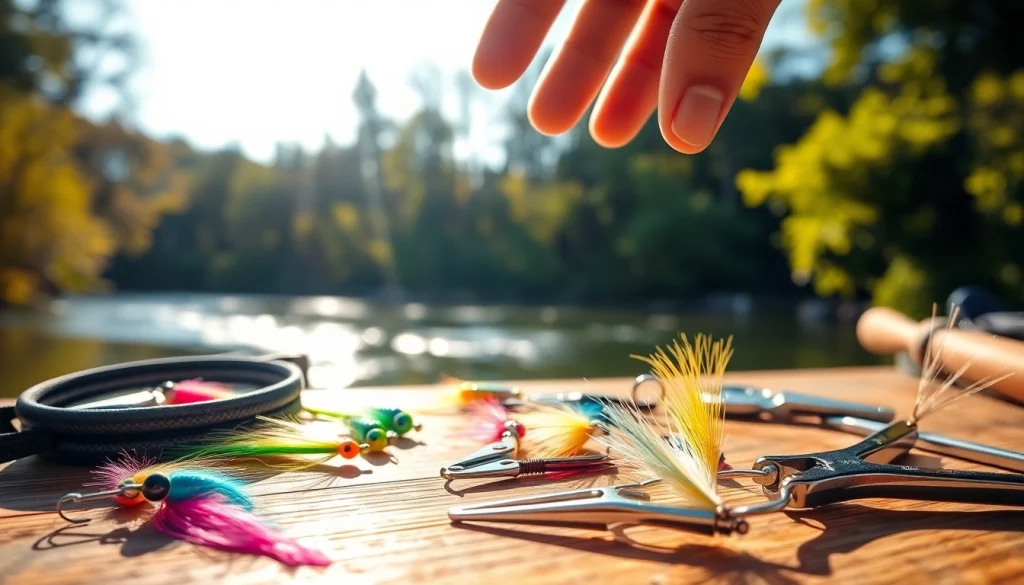Essential Fly Fishing Accessories for the Enthusiastic Angler

Understanding Fly Fishing Accessories
Definition and Importance of Fly Fishing Accessories
Fly fishing, an angling method where artificial flies are used as bait, is not just about the rod and reel. The right Fly fishing accessories are crucial for enhancing the experience, ensuring success, and safeguarding the equipment. Accessories encompass all the necessary tools that assist anglers in effectively practicing this art form, ranging from basic tools to specialized gear.
The importance of fly fishing accessories cannot be overstated. They can make the difference between a pleasurable day on the water and a frustrating one. They improve efficiency, provide safety, and can even enhance your fishing techniques. Understanding these accessories will empower anglers of all levels to maximize their fly fishing experiences.
Common Types of Fly Fishing Accessories
There is an extensive range of fly fishing accessories available, each serving a unique purpose. Common types include:
- Nippers: Essential for cutting line and tippet.
- Hemostats: Useful for removing hooks from fish and ensuring they are handled safely.
- Floatants: Used to keep flies buoyant on the water’s surface.
- Strike Indicators: Help in detecting fish bites by popping up on the water’s surface when a fish takes the bait.
- Tool Kits: Often include various tools like pliers, line clippers, and fly drying materials.
- Waders and Vests: Provide protection against water and tools storage.
Assessing Quality in Fly Fishing Accessories
Quality is a recurring theme when discussing fly fishing accessories. The durability, ease of use, and efficiency of these tools can significantly impact an angler’s experience. Factors influencing quality include:
- Material: Look for durable materials such as stainless steel for tools and high-grade nylon for vests and waders.
- Design: Ergonomically designed tools enhance user comfort and functionality. For instance, lightweight nippers with comfortable grips will make repetitive tasks easier.
- Reviews and Recommendations: Research user feedback and expert recommendations prior to making a purchase can help ensure quality investment.
Key Tools in Fly Fishing Accessories
Nippers and Hemostats
Nippers are small cutting tools that make it easy to trim line and tippet quickly and effectively. Their importance lies in their accessibility—they can often be clipped onto a vest for easy retrieval, saving time during fishing. Investing in high-quality nippers ensures that they can handle different line thicknesses without dulling quickly.
Hemostats serve as multi-functional tools. Beyond merely removing hooks, they can also be used to hold small items or even pinch barbs down for catch-and-release practices. A reliable hemostatic can significantly enhance an angler’s ability to safely handle catches.
Strike Indicators and Floatants
Both strike indicators and floatants enhance fly visibility and functionality on the water surface. Strike indicators, which can be foam, yarn, or plastic, signal bites by fluttering or submerging when struck by a fish. When selecting an indicator, considerations such as weight, color, and buoyancy are crucial, as these elements impact how effectively they perform in various conditions.
In contrast, floatants are repellents that coat flies to prevent soaking (which would sink them). Various options, including gels and powders, provide varying floating abilities, thereby influencing the success rate of dry flies in attracting fish.
Rod Holders and Tool Kits
Rod holders, while seemingly simple accessories, serve a critical function by providing safe and convenient storage for rods while traversing to fish. Their versatility often extends to holding multiple rods securely, allowing for efficiency when managing several fly lines in a day’s outing.
Tool kits typically gather essential tools needed on the water within a convenient carrying case. A comprehensive kit ideally includes snips, hemostats, and other utility tools that can streamline common tasks, minimizing delays during a fishing trip.
Choosing the Right Fly Fishing Accessories for Your Needs
Assessing Your Skill Level
Your proficiency as an angler is vital in determining the accessories suited to your needs. Beginners might prioritize simplicity and ease of use; they often benefit from basic tools that facilitate learning. For instance, using simple, straightforward nippers can eliminate the complexities of advanced gear.
Advanced anglers, on the other hand, might prefer specialized tools designed to enhance their particular technique or tackle larger, more challenging fish. For them, understanding the niche uses of specific fly fishing accessories can improve their overall efficiency and success.
Factors to Consider in Selection
When selecting fly fishing accessories, several factors come into play:
- Fishing Environment: Consider where you’ll be fishing. Wet or rocky environments may require more robust gear.
- Frequency of Use: High-quality tools are ideal for anglers who fish frequently and intensely. Less frequent anglers might opt for budget-friendly options.
- Personal Preferences: Comfort and usability are paramount, ensuring that any tool aligns with your fishing style.
Budgeting for Fly Fishing Accessories
Budgeting is a crucial aspect when selecting fly fishing accessories. While some lower-end products may seem enticing, investing in quality can save money over time with increased durability and performance. Understanding your budget can help guide the decision-making process. It’s advisable to do thorough research to compare prices across various retailers, ensuring the best value.
Care and Maintenance of Fly Fishing Accessories
Cleaning Techniques for Longevity
Proper care of fly fishing accessories ensures longevity and optimal performance. Regular cleaning after each use is essential to remove dirt, salt, and debris. For tools like nippers and hemostats, wiping them down with a damp cloth can suffice. For floats and lines, rinsing them with fresh water is critical, especially after fishing in saltwater.
Storing Fly Fishing Accessories Properly
Storage is another factor in care. Tools should be kept dry and in proper cases or containers to prevent corrosion or tangled lines. Organizing accessories in a dedicated tackle box can also streamline the preparation process, allowing for quick access during fishing outings.
When to Replace Your Accessories
Recognizing when to replace fly fishing accessories is vital for maintaining an effective fishing arsenal. Inspect tools regularly for wear and tear. Dull nippers or rusty hemostats need replacing, as their efficiency diminishes. Additionally, if the floatants start to lose their efficacy, a replacement is warranted to keep your fishing experience productive.
Innovations in Fly Fishing Accessories
Latest Trends in Fly Fishing Accessories
The fly fishing industry continually evolves, welcoming innovative products designed to enhance performance. New advancements often include tools that integrate sustainability, ease of use, and varied functionalities, making the angling experience even more enjoyable. Insights from anglers readily highlight enhancements such as lightweight designs, durable materials, and multifunctional features that solve common fishing frustrations.
High-Tech Gadgets and Their Utility
With technology becoming more integrated into outdoor activities, anglers are now using gadgets such as smartphone apps to predict fish behavior, camera systems to enhance catch tracking, and GPS units to navigate challenging waters. These technologies can drastically improve your fishing experience, allowing for data-driven decision-making in a live fishing environment.
Eco-Friendly Alternatives in the Market
In alignment with growing environmental consciousness, many brands now prioritize eco-friendly materials in their manufacturing processes. Sustainable products range from biodegradable fishing lines to recycling programs for old gear, allowing anglers to enjoy their passion while preserving aquatic habitats.




